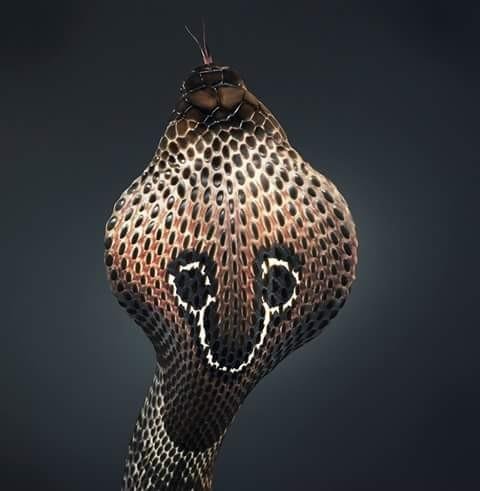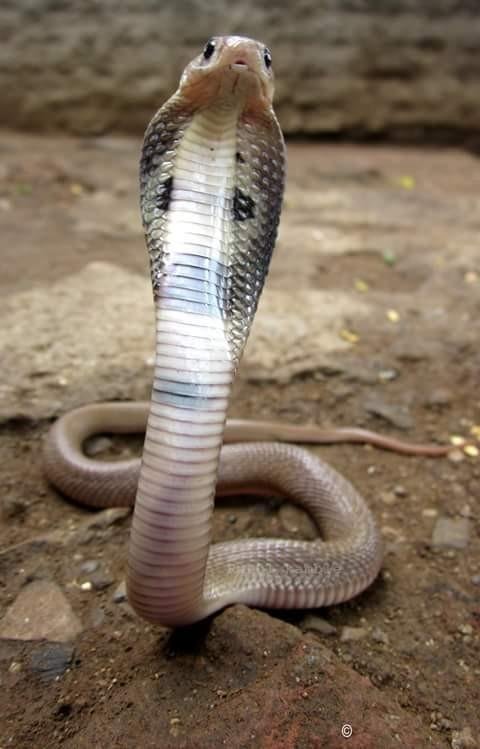Venomous Snake Cobra: Indian cobra complete guide.
Spectacle cobra
Cobra, scientifically known as Naja naja, is one of the poisonous snake species native to the Indian subcontinent. It grows to an average height of 1 m and has two circular ocelli patterns on the rear of its hood. These patterns seem to be connected by a curved line, giving the look of spectacles. This is why the snake is also known as the Spectacled Cobra of India. A newborn cobra measures between 20 to 30 cm, but has fully functional venom glands. Mating Behavior Cobra snake lays its eggs during the period of April to July. The eggs, numbering between 12 and 30 eggs, are laid underground. The incubation period lasts for 48 to 69 days. Diet Spectacled Cobra of India survives on a diet consisting mainly of rodents.

Description
Average length 100 cm,
Scales smooth, glossy.
Head broad
Color, pattern and hood mark variable. Hoodmark sometimes absent.
Shades of Brown, Yellow, gray or black
Dark or Black patternless spectacled Cobras are frequently mistaken for the Central Asian Cobra.
Inject 200-350 mg. venom/bite
Lethal dose of venom is 10-20 mg.
Poisonous effect can start from 5 min. to 2 hours.
Indian Cobra Cobra is usually found inhabiting open forests and farmlands of India. However, one may also see them in Indian cities, living in the sewers and underground drains. Relation with Indian Mythology Cobra snake is widely associated with Indian Hindu mythology. Lord Shiva is often portrayed with a protective cobra coiled around his neck. Lord Vishnu is usually represented as resting on the coiled body of Sheshnag, a snake deity with a number of cobra heads.
DISTRIBUTION: The spectacled cobra is widely distributed across the length and breadth of the country from sea level up to 4000 m (in the Himalayas). The colour varies from black or dark brown to yellowish white. The famous spectacled markings are but a pair of connected rings. In some cobras, the spectacled markings are altogether absent. The cobras of North West India are more blackish in colour and have barely distinguishable spectacled markings.
HABITAT: No fixed habitat like dense jungle or scrub lands. With unchecked habitat destruction, cobras can be found in open places and very close to dwelling places too. Cobras are active both during the night and day.
BEHAVIOUR: Cobras are shy by nature and under most circumstances try to avoid human beings. They would rather hide or flee than fight. But their shyness or timidness should not be taken for granted, because they are hostile when provoked. All cobras are intelligent and provide three distinct warnings before they strike human beings.
It is important to realize that most snake bites from cobras are not life threatening, for the simple reason that the cobra injects very small amounts of venom or no venom at all depending on the severity of the threat. This is called a DRY BITE. (Not life threatening)

CONSERVATION STATUS: Cobras are not classified in the endangered list, but their numbers have been reduced by the loss of habitat.
MOLTING OR SKIN SHEDDING: An adult cobra sheds its skin about six times a year. It provides for vigour and agility.
FEEDING HABITS: All snakes are carnivores. (Lizards, Frogs, toads, insects, rodents, birds)
MATING AND REPRODUCTION: Cobras mate during January and February and lay 12 to 36 eggs, usually in a rat hole or termite mound which hatch within 60 days. The female stays with the clutch, till they hatch, feeding rarely if at all.
SNAKE VENOM: In simple terms is highly modified saliva with a mixture of different kinds of proteins, toxins and enzymes capable of digesting the entire prey. The cobra venom is Neurotoxin in nature and acts on the nervous system and brain. It can lead to respiratory paralysis and cardiac failure.
The venom glands of baby cobras (Hatchling) are as poisonous as a fully grown cobra. Their venom glands are fully functional. A large yolk sac remains in the hatchlings stomach which provides for nourishment up to two weeks, before it needs to find food on its own.
The maximum quantity of venom injected by a cobra is up to 211 mgs. However, a mere 16 mg of venom is sufficient to kill an adult human being.
SYMPTOMS OF COBRA BITE: Convulsions, drowsiness, headache, blurring of vision, slurred speech, limb paralysis, loss of consciousness, nausea, vomiting, intense abdominal pain and severe pain around the bite wound. Increased blood pressure and abnormal heart beats. Good chances of respiratory failure.
TREATMENT: The first snake Antivenom discovered in 1895 by Albert Calmette was due to the significant number of fatalities resulting from the bite from the spectacled Indian cobra.
FIRST AID:
• Reassure the patient to be calm. Explain that 90 % of cobra bites are dry bites and are harmless.
• Do not use tight tourniquets
• Do not allow the patient to exert or walk.
• Raise the leg and cover with blanket.
• In case of vomiting, turn the patient to one side to avoid choking.
• Take the patient to the nearest hospital-Anti venom serum.
RESEARCH ON COBRA VENOM: Research conducted at the Tata Memorial Cancer Institute at Bombay on various fractions of cobra venom has shown promise in treating certain cancer cells in mice. At present, the American pharmaceutical companies have successfully brought out pain killers made from cobra venom-COBROXIN, and NYLOXIN
Thanks for sharing such good information..
my pleasure bro..
Great info...